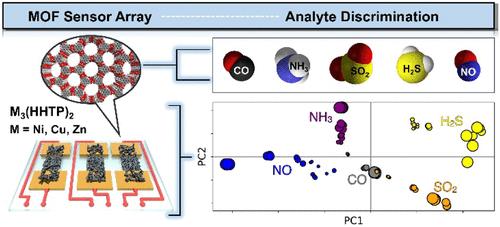Metal–Organic Framework-Based Chemiresistive Array Paired with Machine Learning Algorithms for the Detection and Differentiation of Toxic Gases
IF 9.1
1区 化学
Q1 CHEMISTRY, ANALYTICAL
引用次数: 0
Abstract
The development of low-power, sensitive, and selective gas sensors capable of detecting and differentiating toxic gases is pivotal for safety and environmental monitoring. This paper describes a chemiresistive sensor array comprising a series of three conductive hexahydroxytriphenylene-based metal–organic frameworks (MOFs) (M3(HHTP)2 (M = Ni, Cu, Zn)) capable of detecting and differentiating parts-per-million (ppm) levels of carbon monoxide (CO), ammonia (NH3), sulfur dioxide (SO2), hydrogen sulfide (H2S), and nitric oxide (NO), as well as binary mixtures of SO2 and H2S in dry nitrogen at room temperature. This capability arises from variations in the identity of the linking metal and the framework packing pattern across the materials in the array. To visualize the response pattern of the sensor array and map it to a predicted gas composition, principal component analysis and random forest classification are employed. Both machine learning techniques confirm the ability to discriminate CO, NH3, SO2, H2S, and NO analytes as well as binary SO2/H2S mixtures at ppm concentrations using the response of the array. Moreover, a feature importance method applied to the classifier assigns importance scores to each sensor in the array to quantify the impact of individual materials on analyte discrimination. Spectroscopic investigations provide insight into how the structural features of the MOFs influence sensing performance and ascertain material–analyte interactions governing sensing selectivity for SO2/H2S binary mixtures.

基于金属有机框架的化学电阻阵列与机器学习算法相结合用于有毒气体的检测和区分
开发能够检测和区分有毒气体的低功耗、敏感和选择性气体传感器对于安全和环境监测至关重要。本文介绍了一种化学电阻传感器阵列,由一系列三种导电六羟基三苯基金属有机框架(mof) (M3(HHTP)2 (M = Ni, Cu, Zn))组成,能够检测和区分一氧化碳(CO),氨(NH3),二氧化硫(SO2),硫化氢(H2S)和一氧化氮(NO)的百万分之一(ppm)水平,以及室温下干氮中的SO2和H2S的二元混合物。这种能力源于连接金属的特性和阵列中材料的框架包装模式的变化。为了可视化传感器阵列的响应模式并将其映射到预测的气体成分,采用了主成分分析和随机森林分类。这两种机器学习技术都证实了利用阵列的响应来区分CO、NH3、SO2、H2S和NO分析物以及ppm浓度下的SO2/H2S二元混合物的能力。此外,应用于分类器的特征重要性方法为阵列中的每个传感器分配重要性分数,以量化单个材料对分析物判别的影响。光谱学研究可以深入了解mof的结构特征如何影响传感性能,并确定材料-分析物相互作用对SO2/H2S二元混合物的传感选择性的影响。
本文章由计算机程序翻译,如有差异,请以英文原文为准。
求助全文
约1分钟内获得全文
求助全文
来源期刊

ACS Sensors
Chemical Engineering-Bioengineering
CiteScore
14.50
自引率
3.40%
发文量
372
期刊介绍:
ACS Sensors is a peer-reviewed research journal that focuses on the dissemination of new and original knowledge in the field of sensor science, particularly those that selectively sense chemical or biological species or processes. The journal covers a broad range of topics, including but not limited to biosensors, chemical sensors, gas sensors, intracellular sensors, single molecule sensors, cell chips, and microfluidic devices. It aims to publish articles that address conceptual advances in sensing technology applicable to various types of analytes or application papers that report on the use of existing sensing concepts in new ways or for new analytes.
 求助内容:
求助内容: 应助结果提醒方式:
应助结果提醒方式:


